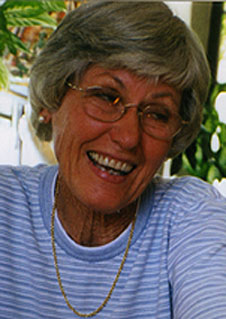by Joan Price
Originally printed in the Summer 2010 issue of Quest magazine.
Citation: Price, Joan. "Many Paths." Quest 98. 3 (Summer 2010): 110.
 Once upon a time there were six blind men who wanted to know what an elephant looked like. The first blind man felt the elephant's side. "The elephant is like a wall." The second blind man ran his hands along the elephant's tusk. "The elephant is like a smooth, taut spear." The third blind man stroked the elephant's trunk. "A snake," he said. "The elephant is like a snake." The fourth blind man ran his hands down the elephant's leg. "The elephant is like a tree." The fifth blind man stroked the elephant's ear. "The elephant is like a fan." The sixth blind man grasped the animal's tail. "The elephant is like a rope." The blind men disputed loud and long. Although each was partly right, all were actually wrong.
Once upon a time there were six blind men who wanted to know what an elephant looked like. The first blind man felt the elephant's side. "The elephant is like a wall." The second blind man ran his hands along the elephant's tusk. "The elephant is like a smooth, taut spear." The third blind man stroked the elephant's trunk. "A snake," he said. "The elephant is like a snake." The fourth blind man ran his hands down the elephant's leg. "The elephant is like a tree." The fifth blind man stroked the elephant's ear. "The elephant is like a fan." The sixth blind man grasped the animal's tail. "The elephant is like a rope." The blind men disputed loud and long. Although each was partly right, all were actually wrong.
The ancient story of the blind men and the elephant goes to the heart of our theological wars. So often religious disputes are waged in ignorance of what the other means, thus, like the blind men and the elephant, we fight about an Ultimate Reality that none of us has seen. When we are opinionated or ignorant of our limitations because of insufficient knowledge or a smug mentality, we are as blind as if we had no eyes. In dogmatic theology as we usually understand it, we may be settling for our limitations by transforming them into absolute truths.
Another analogy, that of a mountain, may help us to understand the ultimate unity of the religions of the world: There are many paths starting at the bottom of the mountain which lead to the mountain top. Each path starts from a different geographical location with respect to climate, terrain, and biological and social conditions. One path proceeds from the jungle, another from the desert, another from the Arctic, and another from a large city. The jungle is wet with dense growth, the desert dry and barren, the Arctic cold and remote, and the city crowded and noisy. It is the ultimate task of religion to help the inhabitants of these diverse regions to find their way up the mountain. Those starting from the desert need to carry large quantities of water, which would not be necessary for those in the jungle—in fact, would hinder them. Arctic climbers need warm, heavy clothing, which would inhibit both the desert dwellers and the jungle inhabitants. City residents might take mobile phones and GPS navigators to find their way in unfamiliar terrain.
Each group would need its own set of instructions for traveling through their particular region. For the Arctic inhabitants to insist that everyone must take warm, heavy clothing to reach the mountaintop, for the desert dwellers to advise climbers in all regions to carry large quantities of water, or for the city residents to insist that all climbers text-message daily would show a lack of understanding of the other paths.
As the paths get closer to the top of the mountain, the terrain becomes more and more similar for everyone no matter where they started. As we climb higher, we begin to see some of the other paths and the people traveling them. Only then can we recognize that the goal of the various religions is the same—to "know thyself."
Joan Price, Ph.D., is professor emeritus of philosophy at Mesa Community College, Mesa, Arizona. She is author of Philosophy through the Ages, Climbing the Spiritual Ladder, and Truth Is a Bright Star, a Native American tale for children. This essay is from the preface of her latest book, Sacred Scriptures of the World Religions: An Introduction, (Continuum, 2010).

